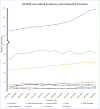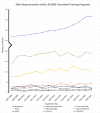Gender Diversity in Orthopaedic Surgery Residencies Does Not Translate to Accreditation Council for Graduate Medical Education-Accredited Fellowships
- PMID: 38751665
- PMCID: PMC11093577
- DOI: 10.2106/JBJS.OA.23.00124
Gender Diversity in Orthopaedic Surgery Residencies Does Not Translate to Accreditation Council for Graduate Medical Education-Accredited Fellowships
Abstract
Introduction: Gender representation among orthopaedic surgery applicants and residents has increased over the past two decades. The aims of this study were to evaluate trends of female fellows in ACGME-accredited orthopaedic subspecialties between 2007 and 2021, and to compare the fellowship trends of female representation to those of ACGME-accredited orthopaedic residencies.
Methods: We conducted a retrospective review of publicly available ACGME-accredited fellowship demographic data from 2007 to 2021. The distribution of genders (male vs. female) across subspecialties and orthopaedic surgery residency programs was compared. Chi-square, Spearman correlation, and logistic regression tests were performed to analyze the relationships between year, gender, and fellowship.
Results: Chi-square analysis demonstrated a significant relationship between gender and year for orthopaedic residency (p < 0.001), but not for any fellowship. There was a significant negative Spearman correlation between the two variables for hand (r(1844) = -0.06, p = 0.02) and sports medicine (r(2804) = -0.05, p = 0.01) fellowships. The negative Spearman correlation for pediatrics (r(499) = -0.09, p = 0.054) approached but did not reach statistical significance. Logistic regression analysis revealed that, holding year constant and comparing to orthopaedic residency, the odds of male participation increased by 173% (95% CI, 1.8-4.1) in spine, increased by 138% (95% CI, 1.7-3.3) in adult reconstruction, increased by 51% (95% CI, 1.3-1.7) in sports medicine, decreased by 41% (95% CI, 0.5-0.7) in hand, decreased by 36% (95% CI, 0.5-0.9) in foot and ankle, decreased by 48% (95% CI, 0.4-0.7) in musculoskeletal oncology, and decreased by 68% (95% CI, 0.3-0.4) in pediatrics.
Conclusion: Although the percentage of female orthopaedic residents in ACGME-accredited programs increased significantly from 2007 to 2021, this has not translated to ACGME-accredited fellowship positions. Future research optimizing methods to improve the representation of females in orthopaedic surgery should be considered.
Level of evidence: III.
Copyright © 2024 The Authors. Published by The Journal of Bone and Joint Surgery, Incorporated. All rights reserved.
Conflict of interest statement
Disclosure: The Disclosure of Potential Conflicts of Interest forms are provided with the online version of the article (http://links.lww.com/JBJSOA/A626).
Figures




References
-
- Association of American Medical Colleges. 2022 Fall Applicant, Matriculant, and Enrollment Data Tables. 2022. https://www.aamc.org/media/64176/download?attachment. Accessed 2023.
-
- Chambers CC, Ihnow SB, Monroe EJ, Suleiman LI. Women in orthopaedic surgery: population trends in trainees and practicing surgeons. J Bone Joint Surg Am. 2018;100(17):e116. - PubMed
-
- Onuoha AC, Meadows AM, Faraj MT, Skinner MM, Day C, Ravi K. Comparative analysis of racial and gender diversity in orthopedic surgery applicants and residents from 2007 and 2019. J Orthop Exper Innov. 2022:31412.
-
- Dib AG, Lowenstein NA, LaPorte DM, Samora JB, Matzkin EG. The pioneering women of orthopaedic surgery: a historical review. J Bone Joint Surg Am. 2022;104(15):e66. - PubMed
Publication types
LinkOut - more resources
Full Text Sources
Research Materials
Miscellaneous
